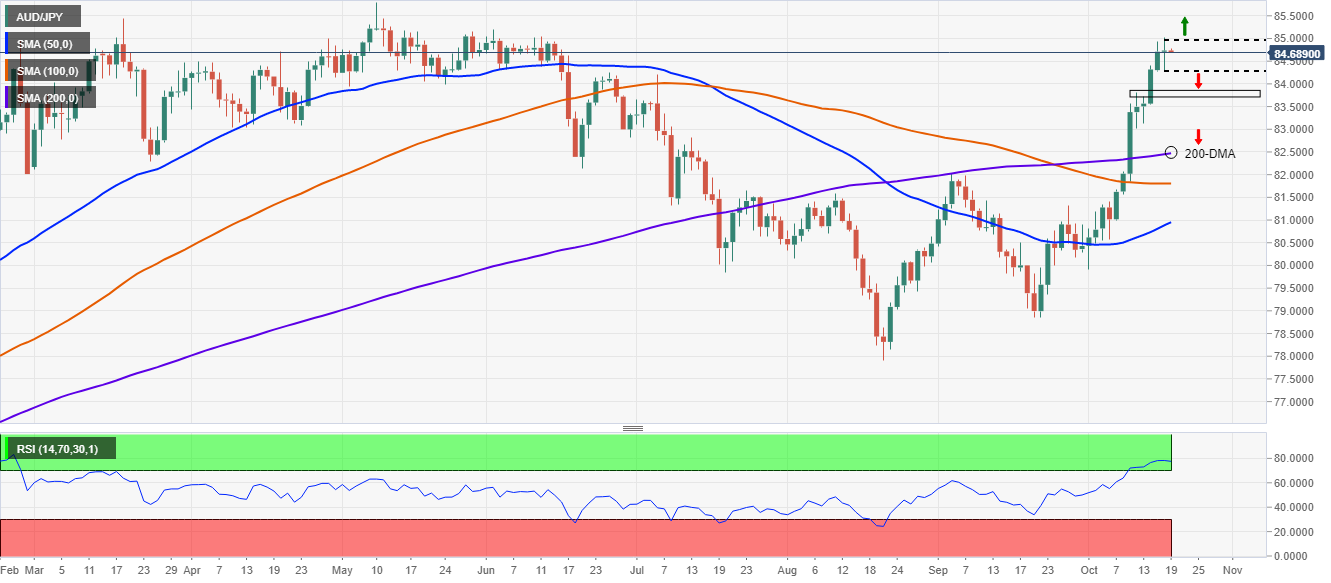- Analytics
- News and Tools
- Market News
- AUD/JPY Price Analysis: An evening-star doji triggers indecision around the 84.50-60 range
AUD/JPY Price Analysis: An evening-star doji triggers indecision around the 84.50-60 range
- Despite a strong upside move in US stocks, the market mood is a mixed bag, as Asian equity futures are mixed.
- AUD/JPY: The prevailing trend still tilted to the upside on the back of the interest rate differentials.
- AUD/JPY: Doji on Monday’s price action and RSI in overbought levels could spur a corrective leg-down.
- AUD/JPY: An upside break opens the door to 2018 highs around 89.00.
The AUD/JPY pair is down 0.02% as the Asian session begins, trading at 84.69 at the time of writing. On Monday, the pair traded within the 84.27-90 range.
The market sentiment is upbeat, even though China’s third-quarter GDP and Industrial production have grown below expectations. Also, heightened inflationary pressures and central banks’ monetary policy tightening weighed on investors’ mood at one time on Monday.
At press time, Asian equity futures are mixed. The Hang-Seng and the Nikkei 225 print gains between 0.01% and 0.32%, while the Australian S&P/ASX 200, the Japanese Topix, and the Chinese China A50 record losses of 0.36%, 0.44%, and 1.83%, respectively.
AUD/JPY Price Forecast: Technical outlook
In the last couple of weeks, the AUD/JPY rallied from 81.00 to 85.00, on the back of risk appetite in the financial markets and the interest rate differential between both countries. From a technical perspective, the daily chart portrays an overextended upside move, which shows that Monday’s price action formed a doji, meaning that indecision surrounds the pair, so it could consolidate before resuming the prevailing upward trend. Furthermore, the Relative Strength Index (RSI), close to 79, in overbought levels, confirms the abovementioned.
A daily break below the 84.27 prices could lead to a downward move towards the before resistance-now support area around 83.80. A breach of the latter would expose the 200-day moving average (DMA) at 82.47.
On the flip side, a clear break above the 84.90 level might see the pair rally towards the May 10 high at 85.80. If buyers could break that supply zone, a test to the 2018’s highs around 89.00 is on the books.

© 2000-2024. All rights reserved.
This site is managed by Teletrade D.J. LLC 2351 LLC 2022 (Euro House, Richmond Hill Road, Kingstown, VC0100, St. Vincent and the Grenadines).
The information on this website is for informational purposes only and does not constitute any investment advice.
The company does not serve or provide services to customers who are residents of the US, Canada, Iran, The Democratic People's Republic of Korea, Yemen and FATF blacklisted countries.
Making transactions on financial markets with marginal financial instruments opens up wide possibilities and allows investors who are willing to take risks to earn high profits, carrying a potentially high risk of losses at the same time. Therefore you should responsibly approach the issue of choosing the appropriate investment strategy, taking the available resources into account, before starting trading.
Use of the information: full or partial use of materials from this website must always be referenced to TeleTrade as the source of information. Use of the materials on the Internet must be accompanied by a hyperlink to teletrade.org. Automatic import of materials and information from this website is prohibited.
Please contact our PR department if you have any questions or need assistance at pr@teletrade.global.















